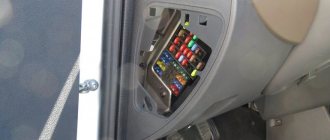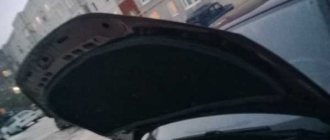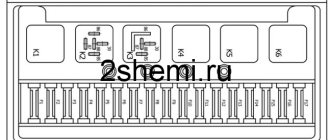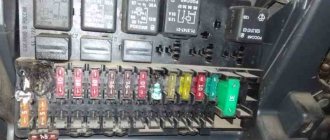While the press was thundering about Bo Andersson's resignation, trying to analyze whether he had done more good or bad, our technicians were lost in service. For a detailed analysis, we purchased the main creation of AvtoVAZ in recent years - the flagship and star of the company Lada Vesta. It was very interesting to see what was hidden inside our main threat to foreign cars. So, let's sort it out.
For “experiments,” a car was purchased, from our point of view, in the most optimal Comfort version, with a 1.6-liter VAZ engine (not yet sold with other Vestas) and a 5-speed manual transmission. We made the choice in favor of the latter after our comparative test drive of Vesta with the AMT “robot”, which, alas, still falls far short of the comfort of a classic “automatic”, although it beats it in price.
By the way, about the price. The cost of the purchased car (with a minimum set of all the options needed today) was 550,000 rubles, taking into account the discount. This is somewhere between 55,000 and 90,000 rubles cheaper than all comparable foreign rivals with approximately the same list of equipment.
Appearance
Looking at the car from the outside, it is worth noting the fact that AvtoVAZ has learned to make even gaps between body elements. Everything looks clear and neat. The front parts of the Vesta body are made of galvanized sheet.
The SV versions are completely galvanized, while the sedans have a roof without a zinc coating.
A distinctive feature of the Classic package is that the handles and mirror caps are not painted in body color. To better seal the opening, in addition to the main seal, there are two additional ones on the door: one at the bottom, the other at the top.
There is a question about the upper seal: couldn’t it be made 10 cm longer? Just ahead, all the dirt flies through the uncovered area. AvtoVAZ began to install normal door stops that have 3 clear fixed positions. Now the door does not hang like a gate.
Fuel level sensor
FLS is exactly what allows you to always see the amount of fuel in Vesta’s tank. It is an integral part of the fuel system, and AvtoVAZ engineers strongly recommend replacing the entire fuel system. The owners of Vest, who have already gone through the replacement of the FLS, say that there are no problems with careful work.
Malfunctions
The FLS fails rarely, but you can notice this if the needle on the fuel level scale reaches 100 without decreasing.
Replacement
To begin, prepare a 10 mm socket, a hammer and a screwdriver. You'll have to "sweat." Sequence of work:
- Remove the rear sofa cushion and the soundproofing sheet underneath.
- You will see a black fuel pump cap. Use a flathead screwdriver to pry it up.
- Disconnect the fuel pump plug from the network.
- Start the engine and let it idle until the fuel that the fuel pump managed to pump to the injector runs out - the car will stall on its own. Turn off the ignition, remove the negative from the battery.
- Compress the springs at the tip of the fuel pump tube and disconnect it.
- Turn the ring counterclockwise (if you can't do it by hand, use pliers) and remove it.
- Tilt the fuel module and disconnect it from the fuel pump.
- Remove the tip from the pressure regulator outlet.
- Unlock the latches of the plug with the wires and disconnect it from the cover.
- Use a screwdriver to disconnect the block mount.
- Disconnect the fuel pump and plug.
- Press out the fasteners and remove the FLS. Install a new FLS. Reassemble everything in reverse order.
Source
Brake pedal sensor
The brake pedal mechanism of the Lada Vesta largely determines the effectiveness of braking: it must timely grasp the force that the driver applies to pressing the pedal. The DPT transmits two signals - A and B via duplex communication, converting them into STP and STP-1 signals. The ECU receives them, sending commands to the brake system about how much force it needs to apply to brake the car.
Malfunctions
A DBR malfunction occurs when the STP and STP-1 signals (about the brake pedal being pressed and released) arrive at the same time in the ECU - the ECU cannot determine which signal to send to the brake system. This problem received error code P0504.
Replacement
Replace in the following sequence:
- move your seat as far back as possible, raise the steering column;
- remove the negative terminal from the battery;
- remove the wiring block from the DPT;
- rotate the part itself 90 degrees counterclockwise and pull it out of the grooves;
- install a new part.
Oil pressure
The oil pressure sensor shows the level of pressure in the oil system, which provides lubrication to moving units and elements in order to reduce the friction force when they come into contact. Insufficient oil pressure will reduce the efficiency of the mechanisms under the hood because most of the energy they produce will be spent on overcoming friction rather than creating useful energy.
Serial photos of Lada Vesta from the plant in Izhevsk
We have already reported more than once about receiving photographs from the plant in Izhevsk. So, in order, what we have.
Workers managed to capture one of the first assembled versions, which stood in the workshop in Izhevsk to be shown to managers
Back view. Someone even sits inside the cabin and looks at the new product
After a while, the management of AvtoVAZ and IzhAvto decided that it was time to “warm up” the audience a little and posted an official photo.
But recently we managed to get pictures of the Lada Vesta painted in new colors.
Reverse sensor
In the Lada Vesta, the reverse sensor works to ensure that the light elements in the rear light unit light up when it is turned on. This feature helps communicate to other road users that the driver intends to move backwards and their view may be obstructed. It warns of a potentially dangerous traffic situation.
With a non-working reverse light, it is unlikely that you will be able to undergo maintenance at an “honest” service station, and this small malfunction is still worth fixing “for yourself” - the white light is more noticeable than the emergency signal, which they so like to turn on when they start to reverse.
Malfunctions
The nature of the malfunction is the same - the indicator light in the rear light does not work. But it may take a long time to find out the reason. There may be several reasons for this:
- there are poor contacts on the sensor elements;
- the light bulbs are burnt out;
- the wires near the converter shorted because they were not insulated;
- wiring is damaged;
- the sensor is broken;
- the fuse is broken.
Examination
In order to localize the problem on Vesta, check:
- operability of the sensor and light bulb - connect them to another circuit;
- fuse, if the “defender” has burned out, it’s time to change it;
- the entire electrical circuit for interruptions.
Replacement
As practice shows, replacing the sensor does not always correct the problem with the reverse light. But if its malfunction is confirmed, buy a new copy and get ready for repairs:
- Turn off the engine. Under the hood, locate the gearbox.
- On it you will see a turquoise colored device. Unscrew it in the same way as the spark plugs.
- Screw the new part in place of the old one.
Other sensors
The operation of the car is literally “tied” to sensors - they transmit information to the computer about the “state of affairs” under the hood, so that the computer issues the correct commands to all components and assemblies and the car works properly. However, many devices are also designed to maintain the level of comfort of the driver and passengers in the car - and they also report the received data to the ECU.
The electronic control unit bears a huge responsibility for receiving and processing data, as well as generating the right commands - without this, a modern car will literally stand still. There are still a lot of “unexplored” sensors in the Lada Vesta.
Outdoor temperatures
DTV on the Lada Vesta shows data on the outside air temperature on the dashboard display. It is installed in the lower left corner of the car engine radiator deflector.
Malfunctions
Its main malfunction is the reflection of inaccurate data on the air temperature outside. In some cases, this may be due to the fact that Vesta simply overheated while standing under the scorching rays of the sun, and shows temperature data of the heated body.
Examination
To check the DTV on the Lada Vesta, it is proposed to assemble the following circuit:
Then connect the DTV to 3.2 V with a constant resistance of 4420 Ohms (creating operating conditions in the car’s electrical network). Using the voltage Ux on the multimeter, determine the performance of the DTV according to the standard resistance.
Replacement
To replace this DTV in Lada Vesta, you will have to remove the front bumper and engine protection in order to get to it and replace it.
The clutch release pedal has a fairly fine organization - all drivers remember this from the times when they learned to drive. It cannot be thrown, because the smoothness of the pairing of the two discs in the clutch block depends on how smoothly the foot releases the lever. Even with a robotic automatic transmission, the clutch works - and it is important that engagement always occurs evenly.
Malfunctions
A malfunction of the clutch sensor manifests itself in the fact that the electronic control unit receives data on the state of the clutch at the wrong time or does not receive it at all. The consequences of interference with operation or malfunction of a part are as follows:
- when connected to the diagnostic connector, error P0830 is displayed;
- when releasing the gas, bumps and jerks are noticed;
- the rpms fluctuate.
Examination
To narrow down the list of “suspects” of a car malfunction to one small detail, we’ll use a multimeter:
- Use a flat screwdriver to move the rod lock to the right position;
- the multimeter probes are connected to the third and fourth terminals of the sensor;
- the rod is in the free position - the circuit is open and the resistance tends to infinity;
- if the rod is clamped and thereby closes the circuit, the resistance will approach zero.
Replacement
The faulty part is located next to the steering shaft and clutch unit.
- Stop the engine and secure the vehicle. Don't press the brake.
- Under the hood, find the green block with wires next to the clutch block, disconnect it.
- Turn the sensor counterclockwise 90 degrees and pull it towards you.
Speeds
Front wheel. Article: 8450006892
Rear wheel. Article: 8450006894
These sensors on the Lada Vesta are installed next to all the wheels of the car - they measure the speed of rotation of the wheels and, through the control unit of the ABS anti-lock braking system, transmit information to the ECU, or more precisely, to the electronic engine management system. The ECU distributes to the wheels the force necessary for movement, including for correct maneuver.
Malfunctions
When they appear in the system, the following symptoms are detected:
- engine thrust decreases;
- smoothness decreases;
- no stability when driving at idle;
- fuel consumption increases;
- the speedometer “lies” or does not work at all.
Examination
First, check the target for a break and the contacts for dirt. Pay special attention to the wires near the plug.
Secondly, you can check without disassembling the car:
- jack up the car so that one of the wheels does not touch the ground;
- connect the sensor contacts to a voltmeter;
- If the voltmeter reads voltage, the system is working.
Replacement
To replace speed sensors:
- Secure the car on the lift at such a height that it is convenient to work.
- On the steering knuckle, find the hole in which the mechanism is located. Remove it.
- Place a new part in place of the old one.
Rear seat
The tailgate has a feature that few people know about. This is a door lock that prevents children from opening it. You need to move the flag down, and the door from the passenger compartment will not open.
It can only be opened from the outside. The rear windows are mechanical. The back of the rear sofa folds in a ratio of 60 to 40.
For rear passengers there are 2 L-shaped head restraints, the third is available only in luxury versions. There are also mountings for Isofix child seats. A significant advantage of the Lada Vesta is its spacious interior. The back row is very roomy, leaving plenty of room for your knees. There is also plenty of headroom.
There is a pocket only in the back of the front passenger seat. There is no courtesy light for rear passengers, nor is there an armrest. But these are minor things.
Engine Lada Vesta
Products from the Dustershop77 range on the topic of the article:
| Name | Manufacturer | Price | Availability | Add to cart |
| DC1822-8200291355 | Crankcase gas recirculation valve Renault 8200291355 | Original | 6900 / 5500 rub. Discount: 4900 rub. | 2 |
| DC380-ASAM-30376 | Lower radiator support cushion 7700430992 / 215081131R ASAM-SA 30376 analogue | Analogue | 150 / 100 rub. Discount: 80 rub. | 4 |
| DC1644-140328698R | Intake manifold gasket H4M original 140328698R | Original | 700 / 600 rub. Discount: 400 rub. | 4 |
| DC1211-8200132254 | Fuel injector for K4M engine original 8200132254 | Original | 2900 / 2200 rub. Discount: 1900 rub. | 4 |
| DC919-226A41772R | Oxygen sensor lambda probe upper Duster, Vesta and other engines. H4M 1.6 226A41772R / 226901841R / 226906393R | Original | 4500 / 4200 rub. Discount: 3900 rub. | 2 |
| DC619-8200048024 | Expansion tank cover original Renault 8200048024 | Original | 700 / 500 rub. Discount: 350 rub. | 2 |
| DC1321-161757436R | Throttle valve gasket H4M/F4R original 161757436R | Original | 800 / 600 rub. Discount: 550 rub. | 2 |
| DC1738 | Fuel pump fuel filter mesh Renault Duster, Captur, Terrano, Vesta, etc. 2.0 / 1.6 (Masuma) | Analogue | 800 / 500 rub. Discount: 350 rub. | 3 |
| DC1398-30777 | Gasket for fuel pump ring ASAM 30777 | ASAM | 300 / 250 rub. Discount: 200 rub. | 3 |
| DC1740 | Fuel filter for submersible fuel pump Renault Duster, Captur, Terrano, Vesta, etc. 2.0 / 1.6 (LYNX) | Analogue | 2100 / 1800 rub. Discount: 1500 rub. | 1 |
| DC1766 | Throttle valve gasket repair kit K4M/F4R (large+small) Balakovo PTP64 | Analogue | 300 / 200 rub. Discount: 150 rub. | 2 |
| DC981-FCR210114 | Electric fuel pump FRANCECAR FCR210114 | Analogue | 1500 / 1200 rub. Discount: 1100 rub. | 1 |
| DC1200-BK64105/30598 | Fuel pump ring with gasket | Analogue | 1000 / 700 rub. Discount: 500 rub. | 1 |
| DC1746 | Membrane of the crankcase gas recirculation valve Renault Duster, Captur, Terrano, etc. (KVKG membrane F4R 2.0) | Analogue | 2200 / 1900 rub. Discount: 1600 rub. | 2 |
| DC1322-224332428R | Ignition coil 1.6 H4m original 224332428R | Original | 3500 / 3000 rub. Discount: 2600 rub. | 9 |
| DC1682-6001549070 | Fuel vapor absorber original 6001549070 | Original | 4000 / 3200 rub. Discount: 2800 rub. | 1 |
| DC1643-140323253R | Intake manifold gasket H4M original 140323253R | Original | 2000 / 1800 rub. Discount: 1600 rub. | 2 |
| LRT-002/6001548140 | Washer reservoir is not original, ANALOGUE 6001548140 | LOGEM | 1000 / 900 rub. Discount: 500 rub. | 1 |
| DC382-ASAM-30494 | Expansion tank ASAM-SA 30494 (7701470460) | Analogue | 1000 / 700 rub. Discount: 600 rub. | 1 |
| DC955-150100565R | Oil pump for F4R original 150100565R | Original | 7500 / 6900 rub. Discount: 6600 rub. | 1 |
| DC1314-135101KT0A | Front crankshaft oil seal H4M original 135101KT0A | Original | 900 / 700 rub. Discount: 550 rub. | 2 |
| DC1320-161191KA1B | Throttle valve H4M original 161191KA1B | Original | 35000 / 29900 rub. Discount: 28300 rub. | 1 |
| DC1664-21179113201000 | Fuel injector VAZ 1.8l 21179 original 21179113201000 | Original | 1800 / 1500 rub. Discount: 1300 rub. | 4 |
| DC2457-8200291355 | Crankcase gas recirculation valve - analogue 8200291355 | Analogue | 4000 / 2400 rub. Discount: 1900 rub. | >10 |
| 6001548140 | Washer reservoir Renault 6001548140 original | Original | 2000 / 1700 rub. Discount: 1500 rub. | 1 |
| DC957-8200665520 | Starter K4M 1.6 original 8200665520 | Original | 13000 / 11500 rub. Discount: 10500 rub. | 1 |
| DC1302-166008992R | Fuel injector for H4M engine original 166008992R | Original | 3500 / 2600 rub. Discount: 2400 rub. | 4 |
| DC1315-122791HC0A | Rear crankshaft oil seal H4M original 122791HC0A | Original | 2000 / 1700 rub. Discount: 1400 rub. | 1 |
| DC1889 | Upper radiator support cushion 215060007R analog | Analogue | 340 / 250 rub. Discount: 200 rub. | 1 |
| DC1663-21120370501015 | Ignition coil VAZ 1.6/1.8 21129/21179 original 21120370501015 | Original | 1900 / 1200 rub. Discount: 900 rub. | 4 |
| DC1836 | Lower thin injector sealing ring Vesta, Largus, X-ray, Granta, Kalina 21127-1139045R (1 pc.) | Original | 25 / 15 rub. Discount: 10 rub. | 4 |
| DC1837 | Valve cover bushing Vesta, Granta, 2108 (1 piece) | Original | 25 / 15 rub. Discount: 10 rub. | 4 |
| DC1838 | Upper thick injector sealing ring Vesta, Largus, X-ray, Granta, Kalina (1 pc.) | Original | 25 / 15 rub. Discount: 10 rub. | 4 |
| DC1839 | Rings for injectors Vesta, Largus, X-ray, Granta, Kalina (set of 8 pcs.) Rosteco | Analogue | 340 / 250 rub. Discount: 200 rub. | 1 |
| DC1878-21080130704204 | Gasket for pump Largus, Vesta, X-Ray, VAZ-2108-2112 21080130704204 | Original | 50 / 30 rub. Discount: 20 rub. | 1 |
| DC522-233009370R | Starter for F4R engine original art. 233009370R | Original | 14000 / 10600 rub. Discount: 9900 rub. | 0 |
| DC918-226A44171R | Oxygen sensor lower lambda probe H4M 1.6 Lambda probe Renault 226A44171R | Original | 32000 / 19000 rub. Discount: 17,000 rub. | 0 |
| DC1002-B208A03276 | Fuel injector for K4M DEKO engine B208A03276 (analogue 8200132254) | Analogue | 2000 / 1500 rub. Discount: 1300 rub. | 0 |
Salon
The door trim is single-texture black. At the bottom there is a spacious pocket that can accommodate a standard 1.5 liter plastic bottle.
Next comes a niche for the speaker of the multimedia system. On more expensive trim levels, the door insert is covered with fabric or eco-leather. Here it is ordinary plastic. Next is the driver's door module: 2 power windows, joystick for adjusting the exterior mirrors. The equipment is the lowest, but the windows and mirrors are electric.
The seats are not combined with dark gray fabric upholstery.
There is no seat lift and no lumbar support. The backrest tilt is adjusted using a lever. This mechanism is more convenient than classic twisters.
Although they provide more precise adjustment of the backrest angle. There is no armrest on the center console. The steering wheel is the simplest without buttons, the trim is unpainted in a black base color.
The steering column is adjustable not only for tilt, but also for reach. This is a useful adjustment that allows you to choose the most comfortable driving position. This configuration, like the more expensive ones, has electric power steering.
There is a standard immobilizer and central locking. Supplied with 2 keys. Moreover, the branded Westovsky key fob with a switching tip is available for all trim levels. The second key is simple without a fob.
Any version of Vesta has 2 frontal airbags: in the steering wheel and instrument panel. At the top of the center console there is an insert for a single-din radio, although a 2-din one can be installed if desired. Audio preparation is provided. Above is a niche for small items. Below is the central locking button, disabling directional stability. The system automatically turns on at speeds above 50 km per hour.
Below is a heater control module with buttons for air flow, turning on the heated rear window and exterior mirrors, two regulators with buttons (air conditioning, interior recirculation). The small display shows the temperature and intensity of airflow. The block looks simple and clear, it is easy to operate.
A wish to AvtoVAZ: the regulators rotate easily, as if idling, there are no clear fixed positions. I think this needs to be improved to improve information content and feedback.
At the bottom of the console there are 2 cup holders, a rubberized shelf for storing small items, and a 12-volt outlet. Instead of a USB output there is a plug.
There is no heating for the front seats, so instead of buttons there are 2 plastic plugs. The gear shift knob is single-textured black.
The glove box is spacious, its volume is 14 liters, there is a lampshade and a stand. There is a closable hole in the side wall that allows you to cool drinks using the air conditioner. Useful thing in the summer.
A diode lighting lamp is installed in the ceiling lining, combined with the Era Glonass unit.
There are also 3 handrails with a microlift installed in the ceiling, except for the driver's seat. Sun visors do not have mirrors.
Rain and light sensor
Rain sensor. Article: 285356725R
These devices on the Lada Vesta provide a comfortable ride. Both of them are installed on the windshield of the car. The rain sensor is activated when the ignition is turned on, when moisture appears on the windshield, and independently activates the cyclic operation of the windshield wipers - the driver does not have to turn them on using the steering column switch.
The light sensor works in a special way. If the DRLs are saved during the day, then in the dark, which is determined by the car itself thanks to these devices, it can turn on the side lights or low beam headlights independently - again, without the driver’s participation in switching the steering column switches.
Oxygen sensor
Catalog number: 226A41772R
The Lada Vesta oxygen sensor transmits data on the oxygen content in the fuel-air mixture to the ECU. The lambda probe consists of a control and diagnostic oxygen sensor. If for some reason they stop transmitting their readings, the ECU will decide to form a fuel-air mixture based on previously received readings, which can cause the mixture to become rich or lean.
Malfunctions
Its operation also directly depends on whether the engine is warmed up: when the car becomes “warm”, the temperature of the probe must reach 300-400˚C for the correct reading of temperatures. If the engine is warm, a malfunction of the DDC and UDC can be identified by the following symptoms:
- speed floats at idle;
- fuel consumption has increased;
- the engine is more difficult to start;
- the engine became less powerful.
Examination
You can check the lambda probe on the Lada Vesta using a multimeter:
- warm up the engine to 90 degrees Celsius;
- use a multimeter (plus) to connect the wire coming out of the sensor that transmits the signal to the ECU, connect the minus to the engine body. Don't get burned on the intake module - it's already very hot;
- measure the voltage level. The norm is 0.2-0.9 V depending on the number of revolutions.
As an unpleasant consequence and “additive” to the failure of the lambda probe, there may also be a failure of the catalytic converter - an important and expensive part of the exhaust gas system, the replacement of which is expensive. Therefore, if you understand that the lambda probe in your Vesta is broken, quickly go for repairs.
Replacement
To begin repair work, determine the cause of the lambda probe malfunction through the diagnostic connector:
- P0136-P0138, P0140, P2271, P2270 – oxygen sensor installed after the catalyst (additional);
- P0131-P0134 – oxygen sensor installed before the catalyst (main);
- P0036-P0141 – DDK heater - after the catalyst;
- P0030-P0032, P0035 – heater of the UEC (main oxygen sensor) installed on the exhaust module.
Based on the data obtained, determine the part that needs to be replaced and carry out repair work:
- Place the car on an inspection ditch. Turn off the engine. Wait for it to cool down.
- Disconnect the block with wires and remove the lambda probe with a 22mm wrench and a 22mm socket.
- Treat the joints with lubricant. Place new parts in place of old ones.











